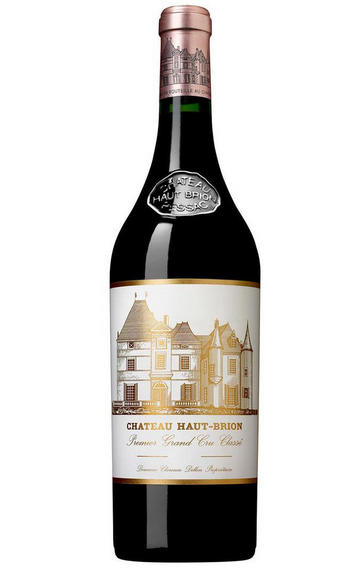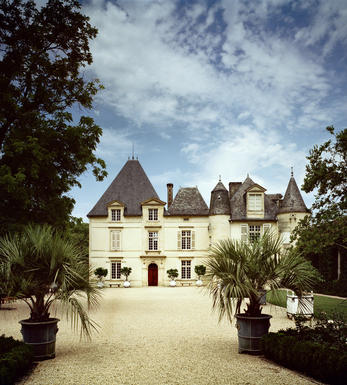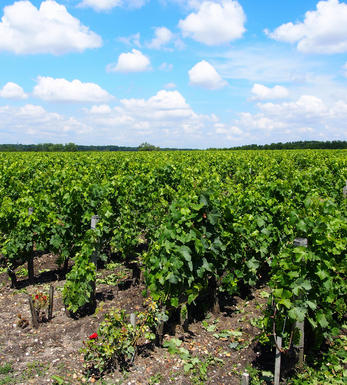
2021 Château Haut-Brion, Pessac-Léognan, Bordeaux

Critics reviews
The 2021 Haut-Brion has a more extravagant, charming bouquet compared directly with the La Mission at the moment, offering copious blackberry, black truffle, undergrowth and menthol scents. The palate is very well balanced, harmonious and poised, with fine-grained tannins and an almost pixelated finish. This Haut-Brion seems to have reveled in the cooler growing season, and at 13.8% alcohol, there is almost a degree less than recent vintages. Jean-Philippe Delmas has fashioned a contender for wine of the vintage.
Drink 2030 - 2065
Neal Martin, vinous.com, (May 2022)
A classical balance, reflecting a vintage that is fairly strict in its aromatic expression, exceptionally successful on this spot. Soft cassis bud, rose petal and rose stem, subdued power that gently builds over the palate. Unquestionably a different architecture to Haut-Brion than over the past few years, and there is a sculpted feel to the cassis and bilberry fruits, still with concentration and weight through the palate, expertly constructed. Feels like a window to the past, and is delicious. Harvest September 13 to October 8, with no Petit Verdot used this year. 73% new oak.
Drink 2028 - 2044
Jane Anson, janeanson.com (May 2022)
Bright crimson-purple. Fragrant berry-fruit notes as the wine opens. Smooth and refined on attack, the mid palate full and generous swathing powerful but integrated tannins. Impressive length and drive. Quite a powerhouse for such a complicated year. Huge potential.
Drink 2032 - 2055
James Lawther, jancisrobinson.com (May 2022)
A candidate for the title of wine of the vintage, the 2021 Haut-Brion unwinds in the glass with aromas of rich red and black fruit mingled with notions of cigar wrapper, licorice, black truffles, loamy soil and burning embers. Full-bodied, deep and concentrated, it's elegant and multidimensional, with superb depth at the core, lively acids and ultra-refined tannins. Combining the classical proportions of the vintages of two decades ago with the viticultural and winemaking of today, it's a timeless classic in the making, but it's difficult to find an obvious analogy with an older vintage. When pressed, Jean-Philippe Delmas suggests a superior version of the 2014 vintage, and to me, a more concentrated, serious version of the 2012 vintage also comes to mind. What is clear, however, is that this is one of the real high points of 2021. The blend is 50% Merlot, 38% Cabernet Sauvignon and 12% Cabernet Franc, and it attained 13.8% alcohol—a percentage point or so lower than in 2020 or 2019.
William Kelley, Wine Advocate (Apr 2022)
A very structured young Haut-Brion with blackberry, blackcurrant, black-olive and mushroom character. Medium to full-bodied with a driving balance of firm and ripe tannins and gorgeous fruit. 50.3% merlot, 38% cabernet sauvignon and 11.7% cabernet franc.
James Suckling, jamessuckling.com (May 2022)
About this WINE

Chateau Haut-Brion
The only property from outside the Médoc to be included in the 1855 Classification, Haut-Brion’s viticultural history can be traced back further than its Médoc First Growth counterparts. Samuel Pepys even mentions it in his diaries. Situated in what is now Pessac-Léognan, the property finds itself now in the suburbs of the ever-encroaching city of Bordeaux.
After falling into a state of disrepair the estate was purchased in 1935 by Clarence Dillon, an American financier, since when it has enjoyed a steady and continual resurgence to a position of pre-eminence. Dillon’s great-grandson, Prince Robert of Luxembourg, now runs the estate, but a key influence in the reputation which Haut-Brion enjoys today is the Delmas family. George Delmas was manager and wine-maker until 1960, when his son Jean-Bernard took over. Jean- Bernard was a visionary figure, responsible for a number of important innovations, and on his retirement in 2003 his son Jean-Philippe took over as Directeur Générale.
The vineyard is planted to 40% Cabernet Sauvignon, 37% Merlot and 18% Cabernet Franc. A stunning white wine is also made, from a part of the vineyard which is 63% Semillon and 37% Sauvignon Blanc. Production is smaller than at the other First Growth Wines, totalling about 20,000 cases, shared between the Grand Vin and a second wine, formerly called Bahans-Haut-Brion but changed in 2007 to Clarence de Haut-Brion in recognition of Clarence Dillon. Production of Haut Brion Blanc is minute, less than 800 cases in most years.
Beginning with the 2009 vintage a new white wine was introduced in the place of Clarence: La Clarté de Haut-Brion, the offspring of Domaine Clarence Dillon's two prestigious white wines: Château Haut-Brion Blanc and Château La Mission Haut-Brion Blanc.
Fermentation of the red wines takes place in stainless steel vats, after which the wine will spend 22 months, sometimes more, in new oak barrels before being bottled unfiltered. For the white wine fermentation takes place in new oak barrels, after which the wine spends a further year to 15 months on its lees in barrel before bottling. The white wine is truly sensational, equivalent in class to a top-flight White Burgundy Grand Cru, but its scarcity means that it is rarely seen.
The red wine is no less extraordinary; at its best it displays text-book Graves characteristics of cigar-box, curranty fruit, earth, smoky spice and cassis. The high Merlot content, compared to the Médoc First Growths, gives it a voluptuous edge, but does not in any way detract from its ability to age.

Pessac-Leognan
In 1986 a new communal district was created within Graves, in Bordeaux, based on the districts of Pessac and Léognan, the first of which lies within the suburbs of the city. Essentially this came about through pressure from Pessac-Léognan vignerons, who wished to disassociate themselves from growers with predominately sandy soils further south in Graves.
Pessac-Léognan has the best soils of the region, very similar to those of the Médoc, although the depth of gravel is more variable, and contains all the classed growths of the region. Some of its great names, including Ch. Haut-Brion, even sit serenely and resolutely in Bordeaux's southern urban sprawl.
The climate is milder than to the north of the city and the harvest can occur up to two weeks earlier. This gives the best wines a heady, rich and almost savoury character, laced with notes of tobacco, spice and leather. Further south, the soil is sandier with more clay, and the wines are lighter, fruity and suitable for earlier drinking.
Recommended Châteaux: Ch. Haut-Brion, Ch. la Mission Haut-Brion, Ch. Pape Clément, Ch Haut-Bailly, Domaine de Chevalier, Ch. Larrivet-Haut-Brion, Ch. Carmes Haut-Brion, Ch. La Garde, Villa Bel-Air.

Cabernet Sauvignon Blend
Cabernet Sauvignon lends itself particularly well in blends with Merlot. This is actually the archetypal Bordeaux blend, though in different proportions in the sub-regions and sometimes topped up with Cabernet Franc, Malbec, and Petit Verdot.
In the Médoc and Graves the percentage of Cabernet Sauvignon in the blend can range from 95% (Mouton-Rothschild) to as low as 40%. It is particularly suited to the dry, warm, free- draining, gravel-rich soils and is responsible for the redolent cassis characteristics as well as the depth of colour, tannic structure and pronounced acidity of Médoc wines. However 100% Cabernet Sauvignon wines can be slightly hollow-tasting in the middle palate and Merlot with its generous, fleshy fruit flavours acts as a perfect foil by filling in this cavity.
In St-Emilion and Pomerol, the blends are Merlot dominated as Cabernet Sauvignon can struggle to ripen there - when it is included, it adds structure and body to the wine. Sassicaia is the most famous Bordeaux blend in Italy and has spawned many imitations, whereby the blend is now firmly established in the New World and particularly in California and Australia.


Buying options
Add to wishlist
Description
Merlot 50%, Cabernet Sauvignon 38%, Cabernet Franc 12%
Jean-Philippe Delmas and team exerted less energy controlling leaf growth, allowing the vine to find its own level of vigour. Monitoring the vineyard was still a full-time effort, but Haut-Brion’s clay and limestone have handled the heavy rains of May and June well. The earlier frosts had little impact, although volumes of the grand vin are down about 20%. The tannins are fine-grained but tense, holding the wine aromatically in check for now. The fruit is beautifully, coolly poised behind the tannins. This is elegant and fine, with all the hallmarks of a wine for the long term. Drink 2030-2055.
Our score: 18.5/20
Berry Bros. & Rudd, April 2022
wine at a glance
Delivery and quality guarantee